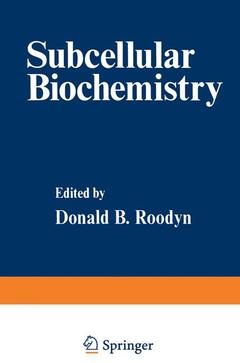Subcellular Biochemistry, Softcover reprint of the original 1st ed. 1978 Volume 5
Langue : Anglais
Coordonnateur : Roodyn Donald

The transition from the quarterly Sub-Cellular Biochemistry to the annual SUBCELLULAR BIOCHEMISTRY is a good opportunity to restate the aims and scope of this publication. They were originally given (in Volume 1 No. 1) as follows: This review and essay journal . . . brings together work on a wide range of topics in sub-cellular biochemistry in the hope of stimulating progress towards an integrated view of the cell. It deals with the biochemistry and general biology of nuclei, mitochondria, lysosomes, peroxisomes, chloroplasts, cell membranes, ribosomes, cell sap, flagellae and other specialized cell components. In addition to articles dealing with conventional biochemical studies on sub-cellular struc tures, the journal publishes articles on the genetics, evolution and biogenesis of cell organelles, bioenergetics, membrane behaviour and the interaction between cell structures, particularly between nucleus and cytoplasm. The first four volumes (in the quarterly format) fulfilled many, but not all, of these stated aims, and it is hoped that further articles in the new annual series will soon fill any deficiencies in the range of topics covered. Over the years we have intentionally not interpreted the title of the publication in a too literal sense. Although we have included specific articles on individual subcellular fractions (and certainly hope to do so again) the publication is definitely not only concerned with studies on the biochemistry of isolated cell fractions. The primary target is the "integrated view of the cell.
1 The Mitochondrial Translation System.- 1. Introduction.- 2. Components.- 3. Protein Biosynthesis.- 4. Products of the Mitochondrial Translation System.- 5. Epilogue.- 6. References.- 2 The H1 Class of Histone and Diversity in Chromosomal Structure.- 1. Introduction.- 2. Physical Properties and Evolution of the H1 Histone.- 3. The Multiplicity of H1 Histones in Higher Organisms.- 4. Changes in the H1 Histone Complement during Development.- 5. Histone Synthesis and Histone Genes.- 6. The Phosphorylation of H1 Histones.- 7. The Conformations of H1 Histone.- 8. A Unifying Overview of the H1 Histones.- 9. References.- 3 Cellular Changes in the Small Intestine Epithelium in the Course of Cell Proliferation and Maturation.- 1. Introduction.- 2. Kinetic Pattern of Cell Proliferation and Renewal in Small Intestine.- 3. The Cell Cycle in the Intestinal Crypt.- 4. Differentiation of the Normal Intestinal Cell.- 5. Cell Proliferation and Differentiation in the Damaged Epithelium.- 6. Conclusion.- 7. References.- 4 Plant Growth Substances as Modulators of Transcription.- 1. Perspectives and Concepts.- 2. Eukaryotic Control of Transcription.- 3. Receptor Proteins of Plant Growth Substances and Transcription.- 4. Plant Growth Substances and Their Action on Transcription.- 5. Proposed Hypothesis for the Mechanism of Auxin Action with Special Emphasis on Transcription.- 6. Conclusion.- 7. References.- 5 Molecular Structure of Biological Membranes: Functional Characterization.- 1. Introduction.- 2. General Remarks on Membrane Structure.- 3. Asymmetrical Distribution of Proteins and Lipids.- 4. Plasma Membrane in Epithelial Cells.- 5. Postsynaptic Membrane of the Vertebrate Neuromuscular Junction.- 6. Plasma Membrane of the Fungus Phycomyces.- 7. Plasma Membrane of Dictyostelium discoideum.- 8. Bacterial Membranes.- 9. Interaction between Membranes, Microtubules, Myosin, and Actin in Nonmuscle Cells.- 10. Conclusion.- 11. References.- 6 Membrane Assembly and Turnover.- 1. Introduction.- 2. The Synthesis of Membrane Components and Their Transfer to Sites of Assembly.- 3. The Assembly of the Endoplasmic Reticulum.- 4. Plasma Membrane Assembly and Turnover.- 5. Mechanisms of Removal of Plasma Membrane Components.- 6. The Removal of Excess Plasma Membrane during Secretion.- 7. Future Perspectives.- 8. References.- 7 Structural Compartmentation of the Cytosol: Zones of Exclusion, Zones of Adhesion, Cytoskeletal and Intercisternal Elements.- 1. Introduction.- 2. Zones of Exclusion.- 3. Zones of Adhesion.- 4. Conclusion.- 5. Summary.- 6. References.- Recent Books in Cell Biochemistry and Biology.- 1. Membranes and Receptors.- 2. Genetics.- 3. Cell Biology and Bioenergetics.- 4. General Topics.
Date de parution : 03-2012
Ouvrage de 390 p.
15.2x22.9 cm
Thème de Subcellular Biochemistry :
Mots-clés :
STR; behavior; biology; cell; cell membrane; chloroplast; cytoplasm; development; evolution; genetics; migration; mitochondria; physiology; structure; system
© 2024 LAVOISIER S.A.S.



